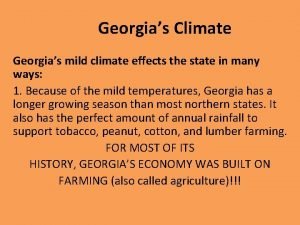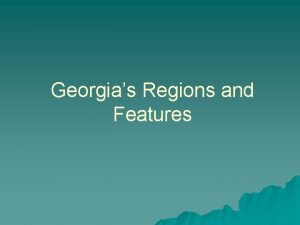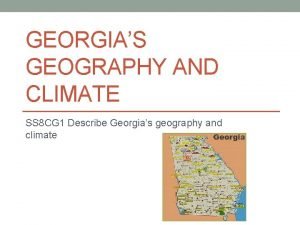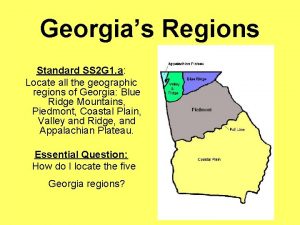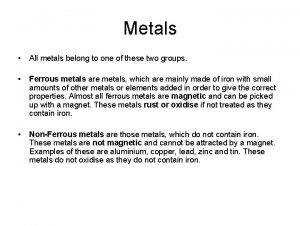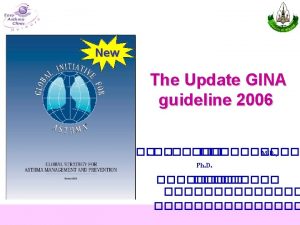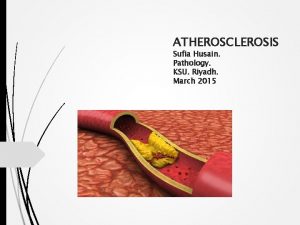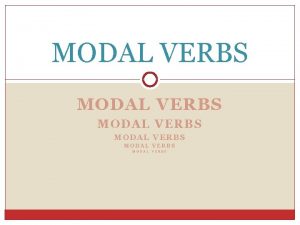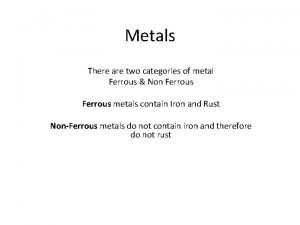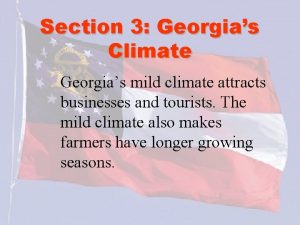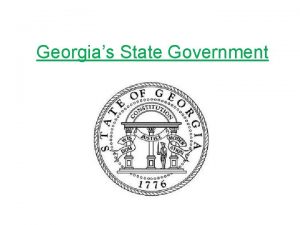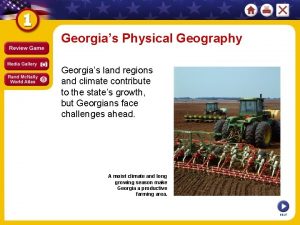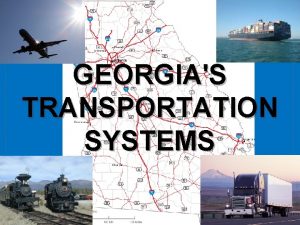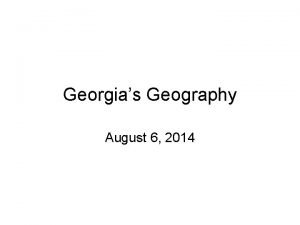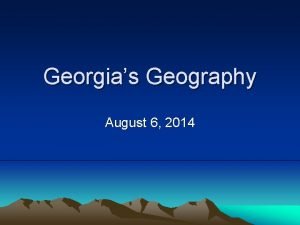Georgias Climate Georgias mild climate effects the state






































































- Slides: 70

Georgia’s Climate Georgia’s mild climate effects the state in many ways: 1. Because of the mild temperatures, Georgia has a longer growing season than most northern states. It also has the perfect amount of annual rainfall to support tobacco, peanut, cotton, and lumber farming. FOR MOST OF ITS HISTORY, GEORGIA’S ECONOMY WAS BUILT ON FARMING (also called agriculture)!!!

Georgia’s mild climate effects the state in many ways: • 2. The cool summers and cold winters in the mountains attract hikers and skiers. (money/tourism)

Georgia’s mild climate effects the state in many ways: • 3. Beach-goers and people escaping cold northern winters will often come to Georgia’s coastal plains. (money/tourism)

Georgia’s mild climate effects the state in many ways: 4. Georgia and it’s neighbor states in the South are part of a warm region of the United States called the Sun Belt. The warm climate has attracted many major corporations to relocate to Georgia.

Show what you know. Based off of what you know regarding Georgia’s location, physiographic regions, physical features and climate, how has Georgia’s LOCATION affected Georgia’s culture, economy, and development? ? ?

Project • In your groups creatively label each region of Georgia. You can use symbols, craft supplies, illustrations etc. to help you to do this.

Project • 1. In your groups you will need to draw an outline of Georgia on a poster. • 2. Label Atlanta with a star. • 3. Label the following cities with a dot – Savannah, Augusta, Milledgeville, Buford, Lake Lanier, Louisville, Macon, and Columbus – Keep it neat because you will be adding more to your poster as the week goes by!

Cool physical features in Georgia!

Appalachian Mountains Chattahoochee River Fall Line Savannah River Barrier Islands Okefenokee Swamp © 2015 Brain Wrinkles

Physical Features • There are many different physical features in the Georgia. • Physical features include bodies of water, deserts, mountain ranges, and other landforms. • They are created by nature; they are not man-made. © 2015 Brain Wrinkles

Physical Feature - Fall Line • The fall line stretches across Georgia. • North of the fall line you will find red clay soil and people get their water from man made lakes. • South of the fall line you will find sandy soil and people get their water from aquifers/wells.

Fall Line © 2015 Brain Wrinkles

Fall Line • The Fall Line is about twenty miles wide and separates the Piedmont region from the Coastal Plain region. • It marks the part of the state where the elevation begins to drastically drop towards sea level. • This causes water to run down hill at an increased rate. © 2015 Brain Wrinkles

Fall Line • In the state’s early days, Georgians built cities like Columbus, Macon, Milledgeville, and Augusta along the Fall Line rivers. • These cities began as places where goods were transferred from boats to wagons and trains. • Today, the Fall Line features some of the state’s most beautiful waterfalls. © 2015 Brain Wrinkles

© 2015 Brain Wrinkles

© 2015 Brain Wrinkles

Okefenokee Swamp • The Okefenokee Swamp is located in the southeast corner of Georgia, and it is one of the largest fresh water swamps in North America. • It covers roughly 700 square miles of the Coastal Plains region. • Its name comes from a Seminole word meaning, “land of the trembling earth”.

Okefenokee Swamp



Okefenokee Swamp • Water in the swamp averages between 2 and 4 feet deep, and there is unstable, marshy ground beneath it. • The Okefenokee Swamp is home to more than 1, 000 types of plants and animals. • In 1937, President Roosevelt created the Okefenokee National Wildlife Refuge, so the swamp is now protected land. © 2015 Brain Wrinkles

© 2015 Brain Wrinkles

Appalachian Mtns. • Nearly 100 miles of the Appalachian Mountain range extends into Georgia. • The southern end of the chain lies within the Blue Ridge region. • These mountains are Georgia’s highest and wettest areas, with more than 80 inches of rainfall every year.

Appalachian Mountains


Appalachian Mtns. • In 1828, gold was discovered in this area of the mountain range and put the town of Dahlonega on the map. • Today, tourists visit the Appalachian Mountains to enjoy the region’s beautiful views and recreational activities.

Physical Feature - Appalachian Mountains

© 2015 Brain Wrinkles

Chattahoochee River • The Chattahoochee River begins in the Blue Ridge Mountains and flows southwest toward Alabama and the Gulf of Mexico. • The Chattahoochee is an important source of water for Georgia, as well as for Alabama and Florida.

Chattahoochee River © 2015 Brain Wrinkles

© 2015 Brain Wrinkles

Chattahoochee River • In the past, cities along the river used it as a source of power for mills and as a means of transportation. • Today, many man-made lakes harness water from the river for hydroelectricity, drinking water, and flood control. • It is also used for recreational activities like kayaking, canoeing, and fishing. © 2015 Brain Wrinkles

Physical Feature - Chattahoochee River • Important river in the development of Georgia! • Forms border between GA and AL. • Major transportation artery used to transport cotton, textiles, and other goods. • Provides hydroelectric power. • Forms Lake Lanier!

Chattahoochee River Lake Lanier

© 2015 Brain Wrinkles

Savannah River • The Savannah River begins in the foothills of the Appalachian Mountains and is the natural boundary between Georgia and South Carolina. • It flows southwest toward Savannah and empties into the Atlantic Ocean. • It’s important for shipping and trade because its deep waters and width make it possible for large ships to navigate. © 2015 Brain Wrinkles

Physical Features - Savannah River • Forms border between GA and SC. • Savannah provides an important deep water ocean port at the mouth of the river emptying into the Atlantic. • Where colonization of GA began.

Savannah River

Savannah River © 2015 Brain Wrinkles

© 2015 Brain Wrinkles

Barrier Islands • Barrier Islands are located along Georgia’s coastline and form a barrier between the mainland the Atlantic Ocean. • These islands protect the mainland from much of the ocean wind, waves, and currents that would otherwise erode the coast. • In Georgia’s early history, forts were built on the islands to protect the state’s coast. © 2015 Brain Wrinkles

Barrier Islands © 2015 Brain Wrinkles

St Simons Island © 2015 Brain Wrinkles

Barrier Islands • Today, some of the islands, like St Simons, Tybee, and Jekyll, are popular vacation destinations for tourists. • Other barrier islands are protected wildlife reserves and wilderness sanctuaries, and cannot be destroyed by manmade developments. © 2015 Brain Wrinkles

Physical Features - Barrier Islands • Provides a natural boundary between the Atlantic Ocean and Georgia’s coast from waves and storms. • Early home to the French. • Today a popular tourist destination. • Forts were built here to defend Georgia from the Spanish.

Barrier Islands

Cumberland Island © 2015 Brain Wrinkles

Appalachian Mountains Chattahoochee River Fall Line Savannah River Barrier Islands Okefenokee Swamp © 2015 Brain Wrinkles

Project • Label each of the important physical features in Georgia. Illustrate it in a way that it will help the you understand its importance. For example, swamp = alligator, River = boat for transportation, etc. You can also bring in yarn, fabric, items from nature etc. to help create you map.

• 7 Natural Wonders of Georgia

Amicalola Falls • • Video Highest waterfall east of the Mississippi. 729 feet tall Name means tumbling water.

Amicalola Falls

Okefenokee Swamp • Video • Notes already taken : )

Okefenokee Swamp

Providence Canyon • Video • Man made in the past 150 years due to erosion and poor farming techniques. • Called Georgia’s “Little Grand Canyon”

Providence Canyon

Radium Springs • http: //www. gpb. org/georgiatraveler/111 springs • Constant 68 degrees • 70, 000 gallons a water a minute gush from this spring. • Traces of radium • Sacred to Native Americans.

Radium Springs

Stone Mountain • • Video 650 feet tall and 2 miles long. Largest Confederate Memorial. Made of granite.

Stone Mountain

Tallulah Gorge • Video • Deep gorge carved into rock with a series of waterfalls. • Popular tourist attraction • Sacred to the Native Americans.

Tallulah Gorge

Warm Springs • Video • Warm, mineral water was known as healing water. • Made famous by Franklin D. Roosevelt. • Water stays a constant 88 degrees.

Warm Springs

Project • Label and illustrate each of the 7 natural wonders of Georgia on your map. • Label the physical features (see notes) • Label the following: Atlanta, Buford, Macon, Savannah, Augusta, Louisville, Columbus, Lake Lanier, Savannah river, Chattahoochee River • Label the regions

Georgia’s 5 Geographic Regions • • • Appalachian Plateau Valley and Ridge Blue Ridge Mountains Piedmont Coastal Plain

How did Georgia’s climate impact development? • Climate – refers to the type a weather a region experiences over a long period of time. • Weather – day-to-day conditions – Georgia’s climate is mild. – We have a good mixture of agriculture and industry because of our climate.

Transportation • 1. How do the four transportation systems in Georgia interact to provide domestic and international goods to Georgians? • 2. How do the four transportation systems provide jobs for Georgians?

What four transportation system interact to provide domestic and international trade? • Interstate Highways (1 -95, 1 -75, 1 -20) • Hartsfield- Jackson International Airport • Deepwater ports - video • Railroads (CSX and Norfolk Southern) - video

Transportation Examples Truck, Ship, Airplane, Train 1. 2. 3. 4. 5. 6. Peaches - Georgia to Oklahoma Automobiles – Japan to Georgia Livestock – Valdosta to Atlanta Peanuts – Georgia to Texas Fresh seafood – Costa Rica to Georgia Lumber – Canada to Georgia
 Okefenokee swamp
Okefenokee swamp Georgias regions
Georgias regions Georgias geography
Georgias geography Georgias colony
Georgias colony Georgias region
Georgias region Climate change 2014 mitigation of climate change
Climate change 2014 mitigation of climate change Mild dyslexia
Mild dyslexia Primary alcohol secondary alcohol
Primary alcohol secondary alcohol Seltzer water and sodas contain a very mild
Seltzer water and sodas contain a very mild Mild psychosis
Mild psychosis Familial hypocalciuric hypercalcemia
Familial hypocalciuric hypercalcemia None mild moderate severe
None mild moderate severe Amnioinfusion
Amnioinfusion Autism vs ocd
Autism vs ocd Remiryl
Remiryl Example of mild steel
Example of mild steel Mild scalp psoriasis pictures
Mild scalp psoriasis pictures Mild hepatic steatosis
Mild hepatic steatosis Maddrey score
Maddrey score Mild left axis deviation
Mild left axis deviation Moderate persistent asthma
Moderate persistent asthma Is there mild dyslexia
Is there mild dyslexia Bending stress of mild steel
Bending stress of mild steel Types of dehydration
Types of dehydration Hypertonic dehydration
Hypertonic dehydration Site:slidetodoc.com
Site:slidetodoc.com Mild persistent asthma
Mild persistent asthma Is the a in aunt capitalized
Is the a in aunt capitalized Mild preeclampsia
Mild preeclampsia Asthma clinical pathway
Asthma clinical pathway Neurocognitive disorder
Neurocognitive disorder Cerebral palsy defination
Cerebral palsy defination Mild moderate severe asthma exacerbation
Mild moderate severe asthma exacerbation Atherosclerosis
Atherosclerosis Hengameh raissy
Hengameh raissy Push hard push fast fully recoil
Push hard push fast fully recoil Ascitic fluid examination
Ascitic fluid examination Amniotic fluid color abnormalities
Amniotic fluid color abnormalities Quick mild cognitive impairment screen
Quick mild cognitive impairment screen Mild autism
Mild autism Mild intellectual disability
Mild intellectual disability Complaint letter purpose
Complaint letter purpose Mild asperger's
Mild asperger's Mild ascites
Mild ascites Fixtures and fastenings in railway
Fixtures and fastenings in railway Hybrid
Hybrid Mild obligation
Mild obligation Mild kognitiv svikt
Mild kognitiv svikt Flame hardening mild steel
Flame hardening mild steel Potassium introduction
Potassium introduction Mild environment definition
Mild environment definition Moderate persistent asthma
Moderate persistent asthma Hypokalemia mild moderate severe
Hypokalemia mild moderate severe Hydrometra uterus
Hydrometra uterus Hirsutism
Hirsutism Categories of metals
Categories of metals Andreas mild
Andreas mild Karnataka state action plan on climate change
Karnataka state action plan on climate change Hát kết hợp bộ gõ cơ thể
Hát kết hợp bộ gõ cơ thể Slidetodoc
Slidetodoc Bổ thể
Bổ thể Tỉ lệ cơ thể trẻ em
Tỉ lệ cơ thể trẻ em Gấu đi như thế nào
Gấu đi như thế nào Thang điểm glasgow
Thang điểm glasgow Hát lên người ơi alleluia
Hát lên người ơi alleluia Các môn thể thao bắt đầu bằng tiếng nhảy
Các môn thể thao bắt đầu bằng tiếng nhảy Thế nào là hệ số cao nhất
Thế nào là hệ số cao nhất Các châu lục và đại dương trên thế giới
Các châu lục và đại dương trên thế giới Công thức tiính động năng
Công thức tiính động năng Trời xanh đây là của chúng ta thể thơ
Trời xanh đây là của chúng ta thể thơ Mật thư tọa độ 5x5
Mật thư tọa độ 5x5
